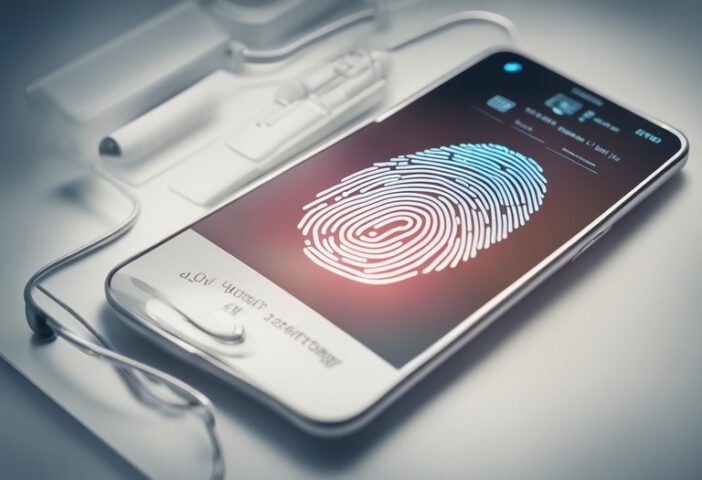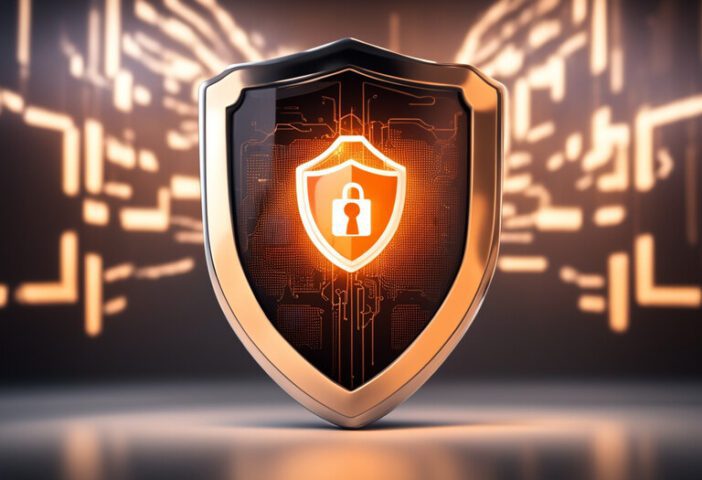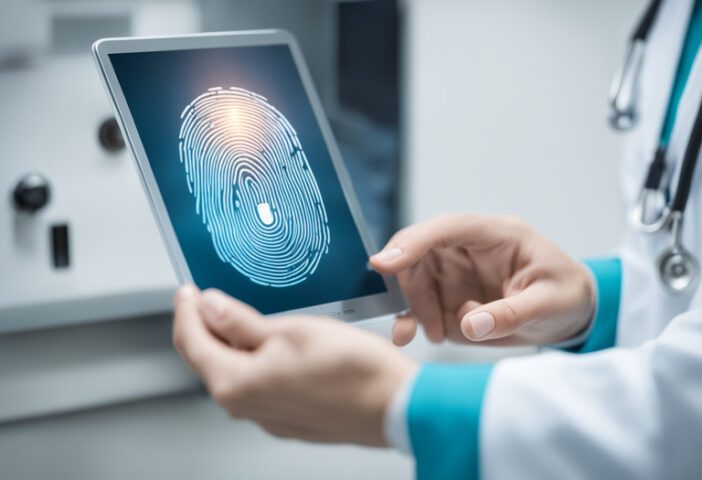In the ever-evolving landscape of healthcare, the integration of digital technologies has revolutionized patient care, streamlined administrative processes, and enhanced the efficiency of medical practices. However, this digital transformation has also brought about new challenges, most notably in the realm of cybersecurity.
In the healthcare sector, the importance of cybersecurity in healthcare patient data is paramount, and the rising threat of cyberattacks and data breaches necessitates a comprehensive and proactive approach to cybersecurity.
In this exploration, we will delve into the intricacies of cybersecurity in healthcare, the potential threats faced, the consequences of data breaches, and the measures taken to protect patient data in this increasingly digital world.


The Digital Transformation of Healthcare
In recent years, healthcare has witnessed a significant shift from paper-based systems to digital platforms. Electronic Health Records (EHRs), telemedicine, wearable devices, and IoT (Internet of Things) medical devices have become integral components of modern healthcare.
These technological advancements have streamlined patient care, improved diagnostic accuracy, and enhanced communication between healthcare providers. However, the adoption of digital systems has also introduced new vulnerabilities that can be exploited by malicious actors.
Potential Cybersecurity Threats in Healthcare
Healthcare organizations are attractive targets for cybercriminals due to the valuable patient data they store. Several cybersecurity threats loom over the sector, each posing unique challenges:
- Data Breaches: Data breaches involve unauthorized access to sensitive patient information, such as medical records and personal data. These breaches can occur through various means, including phishing attacks, malware, or exploiting vulnerabilities in software.
- Ransomware Attacks: Ransomware is a type of malware that encrypts a healthcare organization’s data, rendering it inaccessible. The attackers then demand a ransom for the decryption key. Paying the ransom is not recommended, as it does not guarantee data recovery and may fund further criminal activities.
- Phishing Attacks: Phishing attacks involve deceptive emails, messages, or websites designed to trick individuals into revealing sensitive information, such as login credentials or financial data. Healthcare employees may inadvertently fall victim to phishing, which can lead to data breaches.
- Insider Threats: Not all threats come from external actors. Insider threats involve individuals within the organization who misuse their access to compromise data security. This may be intentional or accidental.
- IoT Vulnerabilities: The proliferation of IoT medical devices, from smart infusion pumps to wearable health trackers, has created new entry points for cyberattacks. These devices often have weak security measures and can be compromised.

Consequences of Healthcare Data Breaches
The repercussions of data breaches in healthcare are extensive, impacting patients, healthcare organizations, and the broader healthcare system:
- Patient Privacy: Data breaches compromise patient privacy, a fundamental aspect of healthcare. Patients entrust their sensitive medical history and personal information to healthcare providers, expecting it to remain confidential.
- Financial Costs: Data breaches result in significant financial burdens on healthcare organizations. The costs include investigations, legal fees, regulatory fines, and potential settlements with affected individuals.
- Reputation Damage: Data breaches can severely damage a healthcare organization’s reputation. Trust is paramount in healthcare, and a breach can erode patient confidence, potentially leading to a loss of business.
- Patient Safety: In some cases, data breaches can have direct implications for patient safety. If medical records or treatment plans are tampered with, it can lead to incorrect diagnoses and treatments.
- Regulatory Penalties: Healthcare organizations are subject to a complex web of data protection regulations, such as the Health Insurance Portability and Accountability Act (HIPAA) in the United States. Violations of these regulations can result in substantial penalties.

Protecting Patient Data in a Digital World
Safeguarding patient data in a digital world is a multifaceted endeavor that requires a combination of technology, policies, and a proactive cybersecurity culture. Here are some essential measures to protect patient data in healthcare:
- Access Control: Implement strict access control measures, ensuring that only authorized personnel can access patient data. This includes the use of strong passwords, multi-factor authentication, and role-based access control.
- Regular Training: Conduct ongoing training and awareness programs for healthcare staff to educate them about the latest cybersecurity threats and best practices for identifying and mitigating them.
- Patch Management: Keep all software and systems up to date with the latest security patches. Cybercriminals often target known vulnerabilities in outdated software.
- Firewalls and Antivirus: Deploy robust firewalls and antivirus software to protect against malware and unauthorized network access.
- Data Encryption: Encrypt data both in transit and at rest to ensure that even if it is intercepted, it remains unreadable to unauthorized users.
- Incident Response Plan: Develop a comprehensive incident response plan that outlines the steps to take in the event of a data breach. This plan should include communication strategies and a chain of command.
- Third-Party Vendors: Evaluate the security measures of third-party vendors who have access to patient data, such as EHR providers or cloud storage services. Ensure they have strong security protocols in place.
- Regular Audits: Conduct regular security audits and assessments to identify vulnerabilities and areas for improvement.
- Backup and Recovery: Implement regular data backup and recovery procedures. This can mitigate the impact of a ransomware attack, as data can be restored from backups.
- Cybersecurity Culture: Foster a culture of cybersecurity awareness and responsibility within the organization. Encourage employees to report any suspicious activity promptly.
- Secure IoT Devices: Ensure that IoT medical devices are secure and regularly updated. These devices should be included in the organization’s overall cybersecurity strategy.

Challenges in Healthcare Cybersecurity
The importance of cybersecurity in healthcare is complex and evolving. Some of the notable hurdles include:
- Resource Constraints: Many healthcare organizations, especially smaller ones, have limited budgets for cybersecurity. This can hinder their ability to invest in robust security measures.
- Human Error: Human error remains a significant factor in cybersecurity incidents. Employees may inadvertently click on malicious links or fall victim to phishing attacks.
- Legacy Systems: Healthcare organizations often rely on legacy systems that may not have the latest security features. These systems can be vulnerable to cyberattacks.
- Patient Data Sharing: As healthcare becomes more interconnected, the sharing of patient data between organizations and across state or national borders poses security challenges.
- Regulatory Compliance: Meeting the demands of healthcare data protection regulations is a complex and ongoing task, requiring dedicated resources and expertise.


In a digital world where healthcare relies on technology for improved patient care, the protection of patient data is paramount. The rising threats of cyberattacks and data breaches in the healthcare sector necessitate a proactive approach to cybersecurity.
The consequences of data breaches are far-reaching, impacting not only healthcare organizations but also patients and the broader healthcare system. To protect patient data effectively, healthcare organizations must employ robust cybersecurity measures, including access control, regular training, patch management, encryption, incident response plans, and more.
Challenges, such as resource constraints and the human factor, must be acknowledged and addressed to ensure the security of patient data remains a top priority. importance of cybersecurity in healthcare is not an option but a fundamental requirement for the digital age, where the sanctity of patient data must be preserved at all costs.































The reputation of the website will surely see an improvement in the near future as a result of the high-quality content and the active involvement of the administrator.
I was recommended this website by my cousin I am not sure whether this post is written by him as nobody else know such detailed about my difficulty You are wonderful Thanks
Thanks I have just been looking for information about this subject for a long time and yours is the best Ive discovered till now However what in regards to the bottom line Are you certain in regards to the supply
Your writing style is so engaging. I couldn’t put this post down.
Hey There. I found your blog using msn. This is
a very well written article. I will be sure to bookmark it and come back to
read more of your useful info. Thanks for the post.
I’ll certainly return.
Its like you read my mind You appear to know so much about this like you wrote the book in it or something I think that you can do with a few pics to drive the message home a little bit but other than that this is fantastic blog A great read Ill certainly be back
Some times its a pain in the ass to read what website owners wrote but this internet site is very user pleasant! .